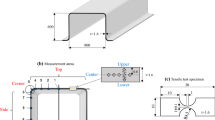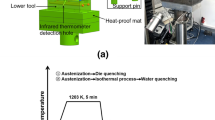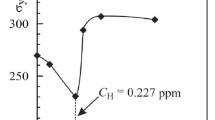Abstract
We study the hydrogen embrittlement and rupture of specimens of high-strength low-alloy steel with weld beads subjected to hydrogenation under the conditions of cathodic polarization. The specimens fail in the heat-affected zone on the boundary between the main metal and the weld bead in the zone of application of the latter and, especially, near its end. This explained by a higher hardness of the metal in this zone caused by the specific features of the temperature field formed in the process of welding.
Similar content being viewed by others
REFERENCES
Z. Lukacevic and I. Samardzic, “Weldability analysis based on probabilistic approach to reliability and weakening of welded joints,” in: 3rd Internat. Seminar “Numerical Analysis of Weldability,” (Graz-Seggau, Austria, September 1995) (1995), pp. 472–485.
Z. Lukacevic, “Quantification of weldability, joint efficiency, and reliability,” in: Proc. of Internat. Conf. on the Joining of Materials — JOM-7, European Inst. for the Joining of Materials, Helsingor, Denmark (1995), pp. 39–48.
Z. Lukacevic, I. Samardzic,and E. Zdjelar “Approach to weldments reliability modelling,” in: Internat.Welding Conf., Japan-Slovak Welding Symp. (Kosice, Slovak Republic, March 1996), Kosice (1996), pp. 210–215.
I. Samardzic, “Temperature fields application in weld repair technique,” in: Proc. of the 19th Internat. Welding Congr., Bratislava (1994), pp. 311–321.
I. Samardzic and A. Stoic, “Weakening due to temperature field variation during welding,” in: Internat. Welding Conf., Japan-Slovak Welding Symp. (Kosice, Slovak Republic, March 1996), Kosice (1996), pp. 261–266.
I. Samardzic, A. Galovic, and M. Galovic, “Nonstationary temperature fields at welding,” Croatian Weld. J. “Zavarivanje,” 36, No.6, 211–217 (1993).
Y. Kobayashi, K, Ume, T. Hyodo, and T. Taira, “The resistance of welded pipelines to sulphide stress cracking,” Cor. Sci., 27, 1117–1135 (1987).
L. W. Tsay, W. L. Lin, S. W. Cheng, and G. S. Leu, “Hydrogen sulphide stress corrosion cracking of 2.25Cr-Mo steel weldments,” Cor. Sci., 39, 1165–1176 (1997).
J. Hidvegy, M. Bursak, and J. Michel, “Fatigue crack growth in welds of high strength microalloyed steel,” Metalurgija, 38, 19–23 (1999).
S. C. Mittal, R. C. Prasad, and M. B. Deshmukh, “Effect of hydrogen on fracture of austenitic Fe-Mn-Al steel,” ISIJ Int., 34, 211–216 (1994).
A. M. El-Batahgy, “A study of cold cracking susceptibility in high strength steel fillet weld joints,” Steel Research, 65, 551–556 (1994).
A. Ikeda, T. Kaneko, and Y. Ando, “On the evaluation method of sulphide stress cracking susceptibility of carbon and low alloy steels,” Cor. Sci., 27, 1099–1115 (1987).
Author information
Authors and Affiliations
Additional information
__________
Published in Fizyko-Khimichna Mekhanika Materialiv, Vol. 41, No. 2, pp. 101–104, March–April, 2005.
Rights and permissions
About this article
Cite this article
Malina, J., Samardzic, I. & Gliha, V. Susceptibility to Hydrogen-Induced Cracking of Weld Beads on High-Strength Structural Steel. Mater Sci 41, 253–258 (2005). https://doi.org/10.1007/s11003-005-0158-y
Received:
Issue Date:
DOI: https://doi.org/10.1007/s11003-005-0158-y




